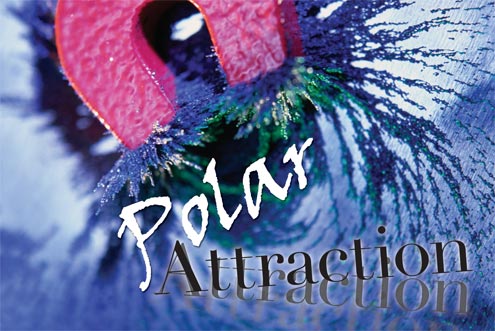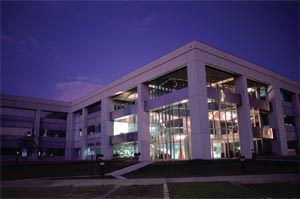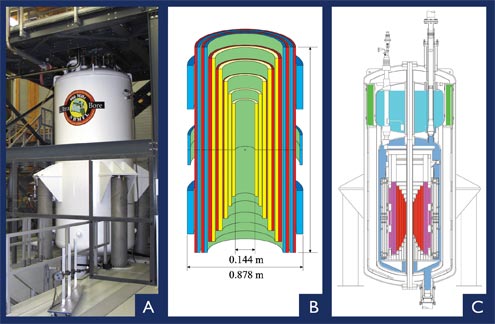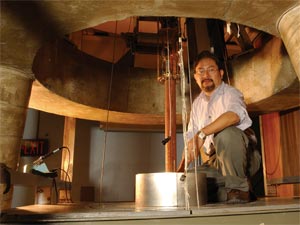|
|
 UF Researchers Are Active Participants In The National High Magnetic Field LaboratoryBy Joseph Kays Fifteen years ago, Florida seemed an unlikely candidate to host the National Science Foundation’s planned National High Magnetic Field Laboratory. The nation’s premier magnet facility was firmly established at the Massachusetts Institute of Technology’s Frances Bitter Laboratory, and most in the magnet science community expected it to stay there.
So when NSF announced in August 1990 that a consortium of the University of Florida, Florida State University and the Los Alamos National Laboratory had been awarded the $61 million contract, the hue and cry in the scientific community was deafening. At MIT’s behest, more than 300 scientists, engineers and students wrote to NSF that moving the lab to Florida “will have a severe negative impact (catastrophic might be the proper word) on Magnetic Lab users for many years, perhaps indefinitely.” Principal investigators Neil Sullivan, a physicist and now dean of UF’s College of Liberal Arts and Sciences, and the late Jack Crow, the lab’s founding director, felt intense pressure to produce world-class magnets fast. And produce they have. As soon as the former insurance company office building in FSU’s Innovation Park was retrofitted and expanded, scientists and engineers began building big magnets in earnest. In June 1994 the lab’s first made-in-Florida magnet powered up to a world record of 27 Tesla, or 540,000 times the Earth’s magnetic field. Since then, numerous other records have fallen. Tesla is a measurement equal to 20,000 times the Earth’s magnetic field. But while these magnet successes have quieted the naysayers, proven the prowess of the Florida team and provided tools for fundamental physicists, their utility to researchers in more applied fields like biology and materials science has been limited by their small bore size — the area at the magnet’s core where experimental samples are placed — and their fluctuating field strength. Bore size is especially important to researchers at UF’s Advanced Magnetic Resonance Imaging and Spectroscopy, or AMRIS, Facility. While physicists and chemists can learn much from microgram-sized samples, imaging a living rat or mouse takes a little more room. So it was with great fanfare that the Magnet Lab unveiled its new 21 Tesla, 900-megahertz, 105-millimeter bore magnet last July. With a bore size of just over four inches, the magnet gives researchers the room they need to get the clearest pictures yet of what’s going on in living biological systems like the brain. “Whole-animal imaging simply couldn’t be done in the other small-bore magnets,” says AMRIS Director Art Edison. “Now we have the real estate to accommodate a whole new level of experiments.” NHMFL Director Greg Boebinger adds: “Whereas our other big magnet projects specialized in making the most powerful magnetic fields, this magnet specializes in precision. The incredibly precise magnetic fields of the 900-megahertz magnet immediately position our chemistry and biology research programs at the forefront of magnetic resonance research — research that will help us understand the workings of biological molecules, as well as the workings of the cell and the brain.” Edison equates the difference between a 3-Tesla human magnetic resonance imaging, or MRI, machine and the new 21-Tesla magnet to the difference between “a lo-res $80 digital camera and a top-of-the-line, hi-res digital camera.” This translates both to improved images and a greater ability to probe the structure of biological molecules. “There is no doubt that this magnet represents a major achievement for this lab,” says UF’s Sullivan. “The ability to do magnetic resonance in the largest volume available anywhere opens up new vistas of science. That was the dream for a magnet many people wondered if we could build.”
The ability to image whole animals is the latest milestone in UF’s long record of biological imaging. UF leveraged its magnet lab partnership to win the first of what would ultimately be more than $50 million in grants from the U.S. Department of Defense and the McKnight Brain Research Foundation to build the McKnight Brain Institute. A key component of the Brain Institute grant proposal was the development of a world-class imaging and structural biology laboratory. About $10 million of that money built AMRIS, which today houses six imaging systems in one wing of the Brain Institute, including magnets rated at 17.6 Tesla, 89 millimeters; 11 Tesla, 40 millimeters; and 4.7 Tesla, 33 millimeters. A seventh system that will be used to study very small amounts of biochemical compounds is on order. Here, in an area where credit cards are always in danger of being wiped clean by the high magnetic fields, UF researchers focus on probing questions about the mysterious activities of the brain and spinal cord of living animals and are also providing detailed views of biological molecules that may be useful drug targets in pharmaceutical research. Over the last 20 years, most people have become familiar with magnetic resonance imaging, or MRI, as a non-invasive, non-nuclear way of looking inside the body. The massive magnets line up the hydrogen atoms in the water in living tissue. Then the machine applies a radio frequency that causes those hydrogen atoms to wobble and give off a signal that can be processed by a computer into a clear image or chemical signature of a molecule. While existing MRI machines continue to provide spectacular detail of physiological structures in tissue samples and small animal models, the new 21-Tesla magnet will provide better, faster images of mice and unprecedented views of ever-smaller structures, like proteins. And, perhaps more importantly, it will allow scientists to map activity in the brain in response to stimuli, directly monitor biochemical reactions in living animals and track the progress of individual cells as they move through a living animal in stem cell and gene therapy. “For example, we can attach drugs or gene therapy treatments to cells and see where they go,” Edison says. “Ultimately, we hope to be able to track a single cell migrating through the body in real time. This would provide a great diagnostic tool to aid in the tremendous regenerative therapies being developed at UF.” Cold FrontAcross campus from the Brain Institute, UF chemists and physicists are using another NHMFL magnet to create unique combinations of extremely low temperature and high magnetic field. When UF’s Microkelvin Laboratory was being constructed in the center of campus in the mid 1980s, researchers knew they needed to go to great lengths to shield the ultra-low-temperature experiments that would be conducted there from vibration and electromagnetic radiation.
Bus and foot traffic is heavy along nearby Stadium Road, and the College of Journalism’s radio and television transmitters and receivers are just a few paces from the lab. So they hung the experimental equipment, called cryostates, from two-ton concrete tripods that stood on foundations of five-ton concrete blocks buried in compacted sand and sheathed them in steel and copper rooms that look like bank vaults. And it works, except for on certain Saturdays in the fall. “I can tell from our data whenever the Gators make a big play,” jokes Jian-Sheng Xia, an associate scientist who runs all of the experiments in the High B/T Facility that occupies the third bay in the Microkelvin Laboratory. Unlike the first two bays, which each use a single 8-Tesla magnet to assist in cooling samples down close to absolute zero, the High B/T Facility employs a second magnet just for experimentation. Funded as part of the original magnet lab grant and opened in 1994, the laboratory offers a combination of high magnetic field (B) and ultra-low temperature (T) that is unmatched anywhere in the world. “The facility is designed to meet the needs of NHMFL users who wish to conduct experiments in high magnetic fields, up to 15.2 Tesla, and at very low temperatures, down to .5 millikelvin, simultaneously,” says Yasu Takano, the High B/T director. “No user facility in the world can provide this combination.” And with the help of a $1.5 million grant from the State of Florida, preparations are under way to equip the facility with a 21-Tesla magnet that will give scientists even greater insights into the fundamental properties. “Nature is like an onion. We keep peeling back layers until we reach the core,” says physics Assistant Professor Yoonseok Lee, director of the Microkelvin Laboratory. “Every increase in field leads to unexplored territory, which is great for the scientific community.” When materials are exposed to these unique conditions, unexpected things can happen. “This branch of physics, which is called condensed matter physics, is so complex that theory can only take you so far, so most of the new discoveries are made through experimentation,” says Takano. “Many Nobel Prize winners have worked in condensed matter physics, and many of those have been in the low-temp area.” As the temperature goes down, materials go through what is known as phase transition, like when water changes from a liquid to a solid. At certain points, especially close to absolute zero, the properties of a system can change completely. For example, a material may become superconducting, meaning it loses all electrical resistance. Superconducting magnets are at the heart of modern magnetic resonance imaging equipment and may one day allow levitating trains to travel at speeds rivaling airplanes. “This combination of ultra-low temperature, just fractions of a degree above absolute zero, and high magnetic field allow scientists to look at the fundamental nature of matter, what we call the ground state,” Takano says. Because the research is so unique, and because experiments here can take up to nine months to complete, the committee of UF scientists that selects the experiments is very picky. “This is hard-core physics. The time, labor and operating costs make it very expensive, so the users committee chooses the experiments very carefully,” says Lee. “They make sure going down to a lower temperature offers promising scientific results.” And the results have been impressive. Lee says all but one user has produced at least one paper in Physical Review Letters, the premier scientific journal of physics. Having the High B/T Facility on the UF campus has greatly benefited the university and helped to increase its reputation in the field of physics, Takano says. “This is a good investment for UF in terms of science and reputation,” he says. “We recently hosted two international conferences — LT24, the major conference of low-temperature physics, and the International Conference on Ultra-Low Temperature Physics.” In addition, Nobel Prize winner Daniel Tsui of Princeton University visited the High B/T Facility last summer and will spend the Spring 2006 semester on sabbatical at the facility conducting experiments. Lee says he was drawn to UF after earning his Ph.D. at Northwestern University and doing post-doctoral research at Stanford because of the unique facilities and opportunity to collaborate with some of the world’s top physicists. “I came here because of this facility,” Lee says. “There are not many places where I could do this kind of research.”
Art Edison Yasu Takano Yoonseok Lee |


